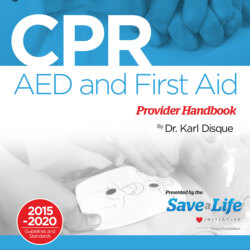CPR, AED & First Aid Provider Handbook

Реклама. ООО «ЛитРес», ИНН: 7719571260.
Оглавление
Dr. Karl Disque. CPR, AED & First Aid Provider Handbook
TABLE of CONTENTS
1. FIRST AID
FIRST AID BASICS
SCENE SAFETY
HANDWASHING AND PERSONAL PROTECTIVE GEAR
Proper handwashing technique is fairly simple:
FIRST AID KIT
Common items found in a first aid kit are:
SELF-ASSESSMENT FOR FIRST AID
ANSWERS
2MEDICAL PROBLEMS
BREATHING PROBLEMS
Technique for using an inhaler:
ALLERGIC REACTIONS
The basic instructions for using epinephrine pens are as follows:
HEART DISEASES
When caring for a person who may be having a heart attack, do the following:
FAINTING
When caring for a fainting person, do the following:
LOW BLOOD SUGAR IN PERSONS WITH DIABETES
When dealing with a person suspected of having low blood sugar, do the following:
STROKE
Persons experiencing a stroke will have symptoms that can include the following:
If you suspect a person is having a stroke, do the following:
SEIZURES
When caring for a person experiencing a seizure, do the following:
After the seizure is over, do the following:
SHOCK
Signs and symptoms of shock include:
When confronted with a person in shock, do the following:
SELF-ASSESSMENT FOR MEDICAL PROBLEMS
ANSWERS
3TRAUMATIC INJURIES
CONTROLLING BLEEDING
To apply a tourniquet, do the following:
TEETH INJURIES
NOSEBLEEDS
PUNCTURES AND IMPALED OBJECTS
EYE PROBLEMS
HEAD INJURIES
Signs and symptoms of a head injury or traumatic brain injury includes the following:
SPINE INJURIES
The following increase the risk of a spine injury:
BONE AND JOINT INJURIES
The first aid care for both sprains and broken bones includes the following:
Call 911 if any of the following are present:
Consider the following as special circumstances that should be discussed:
When dealing with an amputation, do the following:
To care for an amputated part, do the following:
BURNS AND ELECTRICAL INJURIES
Small burns can be treated with first aid by doing the following:
Call 911 when the following occur:
When caring for a person with a large burn, do the following:
SELF-ASSESSMENT FOR TRAUMATIC INJURIES
ANSWERS
4ENVIRONMENTAL INJURIES AND ILLNESSES
BITES AND STINGS
Signs and symptoms that suggest a more serious reaction includes:
TEMPERATURE RELATED ILLNESSES
When treating a person with heatstroke, immediately do the following:
SUNBURN
FROSTBITE
To provide first aid for frostbite, do the following:
HYPOTHERMIA
Signs and symptoms of hypothermia are:
Call 911 immediately and do the following:
TOXIN AND POISON EXPOSURE
To provide first aid in these situations, do the following:
SELF-ASSESSMENT FOR ENVIRONMENTAL INJURIES AND ILLNESSES
ANSWERS
5ADULT CPR, AED AND CHOKING
ADULT CPR
For adult CPR, do the following:
COMPRESSIONS
For chest compressions, do the following:
GIVING BREATHS
To open the person’s airway, do the following:
Now you are ready to give breaths. Do the following:
MASK USE
When using a mask to give breaths, do the following:
AED FOR ADULTS
TO USE AN AED, DO THE FOLLOWING:
ACTIVATING EMS (CALLING 911)
CHOKING IN ADULTS
RELIEF OF CHOKING. Abdominal Thrusts (Heimlich Maneuver)
To perform the Heimlich maneuver, do the following:
SELF-ASSESSMENT FOR ADULT CPR, AED AND CHOKING
ANSWERS
6CHILD CPR, AED AND CHOKING
When giving CPR to a child, do the following:
CHILD CPR (1 YEAR TO PUBERTY)
COMPRESSIONS
To do CPR on a child, do the following:
GIVING BREATHS
To open the child’s airway, do the following:
Now you are ready to deliver breaths. Do the following:
MASK USE
When using a mask to give breaths, do the following:
AED FOR CHILDREN
To use an AED on a child, do the following:
ACTIVATING EMS (CALLING 911)
CHOKING IN CHILDREN
RELIEF OF CHOKING
To relieve choking in a child, do the following:
SELF-ASSESSMENT FOR CHILD CPR, AED AND CHOKING
ANSWERS
7INFANT CPR AND CHOKING
When giving CPR to an infant victim, do the following:
INFANT CPR (0 TO 12 MONTHS)
COMPRESSIONS
To give an infant CPR, do the following:
GIVING BREATHS
To open the infant’s airway, do the following:
Once you’ve opened the infant’s airway, you are ready to give breaths. Next, do the following:
If unable to cover both mouth and nose entirely with your mouth, use the following method for rescue breathing:
MASK USE
When using a mask to give breaths, do the following:
ACTIVATING EMS (CALLING 911)
CHOKING IN INFANTS
RELIEF OF CHOKING
When an infant is choking, do the following:
SELF-ASSESSMENT FOR INFANT CPR AND CHOKING
ANSWERS
8 ADDITIONAL TOOLS. MEDICODE
CERTALERT+
9CPR REVIEW QUESTIONS
ANSWERS
Отрывок из книги
First Aid Basics
.....
Self-Assessment for Environmental Injuries and Illnesses
Chapter 5 Adult CPR, AED and Choking
.....